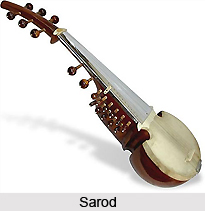 Sarod is one of the leading concert instruments of North Indian Classical Music. This string instrument is most likely non-Indian in origin. The Sarod has four melody strings tuned to Sa, Pa, Sa, Ma and it is played with a triangular plectrum.
Sarod is one of the leading concert instruments of North Indian Classical Music. This string instrument is most likely non-Indian in origin. The Sarod has four melody strings tuned to Sa, Pa, Sa, Ma and it is played with a triangular plectrum.
History of Sarod
The details of its development in India are quite different to trace. In all likelihood, it originated from the Rebab, an instrument from the Middle East. Its use in Indian Classical Music can be traced back to one of the master musicians of Indian music, Tansen. He was one of the most fantastic singers andBbinkars in the court of the Mughal emperor Akbar. Today, the Rebab has been replaced by the Sarod in the performances of Indian Classical music. It is said that Khan Saheb Asadullah Khan introduced the Sarod in Bengal over a century ago, and since then Bengal has become noted for the manufacture and popularization of this instrument.
Structure of Sarod
It has a hollow circular belly to which is attached a tapering neck whose slim top portion holds the tuning pegs. Therefore it is a lute-type instrument. The shape of the belly of the instrument is distinctive in that it is pinched just below the place where the neck is attached. The use of wood for the belly of the Sarod and the use of parchment to cover the belly were retained from Rebab construction. The Sarod is usually three to three and a half feet long and has a body of teakwood overlaid with a fingerboard of polished metal, which facilitates sliding the finger along the strings. One of the distinctive features of the Sarod is that unlike the other string instruments it does not have a fret. The job of the frets is done by the left hand which is used for stopping the strings along the smooth fingerboard.
There are mainly two types of sarods namely the sarod with six pegs and the sarod with eight pegs. Both are equally developed but have distinctive features of their own. There are four or five metal strings on the Sarod. These are tuned Pa Sa Pa Sa Ma and Sa Pa Sa Ma, respectively. The lowest string is brass and the rest are steel. The lowest-pitched string, Kharaj Sa (or Pa), is closest to the player`s face. In addition, there are three to five Chikari (drone and rhythm) strings and anywhere from eleven to sixteen sympathetic strings.
The Sarod has four bridges, the main one that sits on the parchment over the belly, a secondary bridge (called a Jawari bridge) at the neck of the instrument, and two smaller bridges attached to the pegged side of the instrument. The Jawari bridge is wide, and is constructed such that it will add a buzz to the sounds produced by the four strings it supports (one drone string and three sympathetic strings, all of which are called jawari strings because they cross that bridge). The main bridge holds strings at three levels. Over the top go the playing strings, one jawari string (a drone string tuned to Sa), and the other two drone strings (tuned to Sa and Sa). One level down, the remaining three jawari strings (the sympathetic strings) go through small holes in the bridge. The lowest level of holes is for the remainder of the sympathetic strings. The sympathetic strings, called tarab, are all made of steel.
Playing of Sarod
The Sarod is played with a plectrum held in the right hand. The plectrum is like a rounded-off triangle about one and a half to two inches across the base and from apex to base. The apex hits the strings. The plectrum is made either of coconut shell or of wire. Its base is embedded in beeswax so that it is easier to hold between the thumb and index finger.
Famous Sarod Players
Sarod players are often called Sarodiyas. One of the earliest among them is Mohammad Amir Khan (1873–1934). He was the court musician of Darbhanga and Rajshahi. Two of the most well know Sarod players in India are Sharan Rani and Ustad Amjad Ali Khan. Here is a list of famous Sarod players or Sarodiyas from India.
Allauddin Khan
Hafiz Ali Khan
Ali Akbar Khan
Bahadur Khan
Buddhadev Das Gupta
Kalyan Mukherjee
Sakhawat Hussain
Radhika Mohan Maitra
Vasant Rai
Rajeev Taranath
Aashish Khan
Brij Narayan
Narendra Nath Dhar
Biswajit Roy Chowdhury
Vikash Maharaj
Tejendra Majumdar
Amaan Ali Khan
Ayaan Ali Khan
Abhisek Lahiri
Aayush Mohan
Wajahat Khan
Arnab Chakrabarty
Soumik Datta
Prithwidev Bhattacharyya
Abhishek Borkar
Debanjan Bhattacharjee
Debasmita Bhattacharya
Vishal Maharaj




















